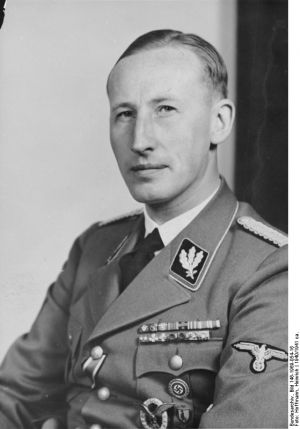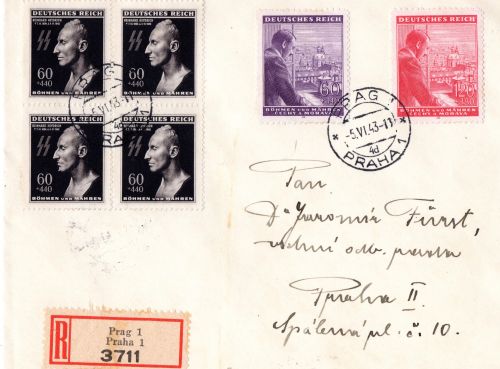Reinhard Heydrich

Reinhard Heydrich
Reinhardt Heydrich was born in Halle, Germany, a provincial town in Prussian Saxony, on 7 March 1904. He was the son of a Dresden music teacher who had founded the First Halle Conservatory for Music, Theatre and Teaching. Heydrich joined the Freikorps in 1919 and was strongly influenced in his early years by the racial fanaticism of volkisch circles. On 30 March 1922 he entered the Reichsmarine in Kiel, serving for a time under Wilhelm Canaris, who nurtured his taste for naval intelligence work. In 1931 Heydrich was forced to resign from the navy by Admiral Raeder for ‘conduct unbecoming to an officer and a gentleman,’ after compromising the virtue of a shipyard director’s daughter.
In July 1931 he joined the Nazi Party and then the SS, attracting the attention of Heinrich Himmler and he rose rapidly through the ranks. He was appointed SS- Sturmbannführer on 25 December 1931, then SS- Standartenführer and Chief of the SD (Security Service) in July 1932. Heydrich was promoted to SS- Brigadeführer on 21 March 1933 and, in reward for his murderous services during the Ernst Rohm putsch, he became an SS- Obergruppenführer on 1 July 1934. Around the time he became a SS- Sturmbannführer he dropped the t from his Christian name, and henceforth was known as Reinhard. Heydrich was tall, slim, blond-haired, with slanting, deep-set blue eyes. He possessed a military bearing and ice-cool hardness, which seemed to epitomize the ‘Nordic- Aryan type’ of Nazi mythology. His athleticism – he was a first-class fencer, an excellent horseman and a skilled pilot – allied to his talent as a violinist and his orderly, disciplined exterior impressed Himmler, who selected him as his right-hand man.
As Himmler’s assistant in securing control of the Munich and then Bavarian police after the Nazis seizure of power, Heydrich assured the successful co-ordination of the political police in the other German Landser during 1933 -4. Heydrich soon intrigued his way to becoming Chief of the Berlin Gestapo and by 1936 was given command of the security police throughout the Reich. An able technician of power, ruthless, cold and calculating, without any compunction in carrying out the most inhuman measures, Heydrich made himself indispensible to the masters of the Third Reich. Yet the arrogant facade disguised a deeply split personality, a neurotic temperament and pathological self-hatred which found its outlet in a boundless greed for power, morbid suspiciousness and exhibitionism. A sense of ‘racial’ inadequacy, the gnawing uncertainty caused by his suspected half-Jewish origins – utilised for blackmail purposes by his rivals for power, though never established as a fact. All this added to his built-in sense of inferiority.
As head of the SIPO, the unified, centralised, militarised and Nazified security police, Heydrich reacted with pitiless harshness in dealing with ‘enemies of the State.’ His cynicism and contempt for human beings led him to exploit the basest instincts – sadism, envy, intolerance – in weaving his gigantic spider’s web of police surveillance in the Third Reich. He filed extensive dossiers not only on enemies of the Party, but also on his rivals and colleagues, using the police apparatus to set his opponents at each other’s throats. Scientific studies of the modus operandi of potential enemies of the State like Marxists, Jews, Freemasons, Liberal Republicans, religious and cultural groups went hand in hand with arrests, torture and murder of those who stood in the way of the totalitarian police apparatus.
The ‘Blond Beast’ who controlled the sole intelligence service of the Party afer 1935, specialised in devious methods of blackmail alongside the weapons of open terror and persecution. Heydrich’s hand was most probably in the Tukhachevsky Affair – which led to the purge of the top Red Army generals in the Soviet Union – and he fabricated the scandalous intrigue which brought down the leading German generals von Blomberg and von Fritsch in 1938. His proclivity for ‘dirty tricks’ was again in evidence when he masterminded the fake attack on the Gleiwitz radio transmitter station, which provided Hitler’s excuse for invading Poland, on 1 September 1939. In the same year Heydrich was appointed head of the Reich Main Security Office (RSHA) which incorporated the Gestapo, the criminal police and the SD. A gigantic political machine for centralising and transmitting information to all corners of the Third Reich, which gave Heydrich the opportunity to perfect the techniques of secret police power.
The most satanic consequence of this accumulation of power was revealed in Heydrich’s implementation of the order for the wholesale extermination of European Jewry. Already before the war, Heydrich had concentrated the management of Jewish affairs in his hands, though in 1938 the emphasis was still on a policy of forced emigration. One of the instigators of the Crystal Night pogrom of November 1938, Heydrich had sent Adolf Eichmann to Vienna to organise a ‘Centre for Jewish Emigration’ and, impressed by his success, had created a similar centre in Berlin.
After the conquest of Poland, Heydrich ordered the concentration of Polish Jews in ghetto’s and the appointment of Jewish councils, a characteristically perfidious of forcing the Jewish communities to ‘collaborate’ in their own destruction. With Eichmann’s help, he organised the mass deportations of Jews from annexed parts of Poland, Germany and Austria to the territory of the General- Gouvernement. In his directive of 21 September 1939 Heydrich distinguished, however, between the ‘final aim,’ requiring longer periods of time and the stages required or achieving it. On 31 July 1941, following the invasion of the Soviet Union, in the first six weeks of the campaign Heydrich had, with typical bravado, had flown with the Luftwaffe, Goering commissioned Heydrich to carry out a ‘total solution of the Jewish question in those territories of Europe which are under German influence.’ Both the terms Gesamtlosung (Total Solution) and Endlosung (Final Solution) were used in the document and Heydrich was delegated to take responsibility for all the necessary organisational, administrative and financial measures. His Einsatzgruppen which had already killed tens of thousands of Poles and Jews with the co-operation of the German Army, were to murder hundreds of thousands of Russian and Polish Jews as well as Soviet officials.
To co-ordinate the action of various government and Party agencies, Heydrich convened the Wannsee Conference in a Berlin suburb on 20 January 1942, to discuss the ways and means of implementing the ‘Final Solution of the European Jewish Question.’ In the circumlocutory language used to disguise the policy of mass murder, which he had a considerable part in devising. Heydrich described how Jews capable of work ‘ are brought to these areas in the eastern occupied territories and employed in road building, in which task undoubtedly a large part will fall out through natural diminution.’ In other words they would be sent to their death through hunger, exhaustion or disease and, where required, by murder squads. The surviving remnant would be given appropriate ‘treatment’ as they represented a ‘natural selection,’ constituting the ‘germ-cell’ of a new Jewish development should they be allowed to go free.’ Having laid the groundwork for the ‘Final Solution’ Heydrich left his Berlin headquarters to assume the post of Deputy Reich Protector of Bohemia and Moravia on 23 September 1941. Taking up residence in Prague, Heydrich adopted ‘the policy of the whip and the sugar,’ speeding up repression and ordering mass executions while attempting to win over the workers and peasants by improving social conditions. Overestimating his success in ‘pacifying’ the Czechs, Heydrich abandoned normal security precautions and drove about in an open car without armed escort. On 27 May 1942 he was gravely wounded by two Free Czech agents, Josef Gabcik and Jan Kubis, who were trained in England and parachuted into Czechoslovakia, who opened fire on his car and when the gun jammed threw a grenade into the vehicle. The assassins were discovered, along with other members of the Resistance group, sheltering in the St. Cyril and Methodius church in Prague. On the 18 June 1942 after a pitched battle with scores of SS troops, Josef Gabcik killed himself in the crypt, while Jan Kubis was fatally wounded and died in hospital.
On 4 June 1942 Heydrich died at 04.30 in the morning from blood poisoning and four days after his death, about 1,000 Jews left Prague in a single train which was designated ‘AaH’ (Attentat auf Heydrich— Assassination of Heydrich). This transport was officially destined for Ujazdów in the Lublin district, Poland, but was gassed at the Bełżec death camp. The members of Odilo Globocnik’s resettlement staff henceforward dedicated the murder programme to Heydrich’s memory under the code name Einsatz Reinhardt. Heydrich’s body was transported from Prague by special train to Berlin and his funeral on 9 June 1942 was the grandest of any funeral ceremony conducted during the history of the Third Reich, held in the Mosaic Hall of the Reichs Chancellery on Vos-strasse. Following the funeral oration delivered by Hitler, the coffin was transported through the streets of Berlin on a gun carriage towed by a half-track to a simple grave in Invaliden cemetery. As Heydrich was being buried Hitler ordered the complete destruction of the little Bohemian village of Lidice as retaliation for the assassination of Heydrich on 9 June 1942, under the command of SS- Hauptsturmführer Max Rostock. See the article: The Destruction of Lidice for the complete account of this dreadful tragedy.

Envelope with Heydrich's Death Mask Stamps 1943
Sources:
Robert Wistrich, Who’s Who in Nazi Germany, Routledge, London 1995
G. Reitlinger, The Final Solution, Sphere Books Ltd, London 1971
Ray Cowdery and Peter Vodenka, Reinhard Heydrich: Assassination, USM Incorporated Lakeville USA 1994.
Photograph – Bundesarchiv
Envelope - Chris Webb Private Archive
© Holocaust Historical Society 2017



